On Sunday’s episode of Dexter, Miami Metro unearthed a pair of rotted corpses wrapped in a shower curtain: the long-buried victims of this season’s obligatory serial killer, Wayne Randall. If you were watching in HD, you may have noticed the skeletons’ disturbingly realistic remnants of hair and muscle or the cockroaches emerging from at least one orifice. That gory scene was masterminded by Joshua Meltzer, the prop master responsible for crafting all the blood, body parts, crime scenes, and weapons in Dexter Morgan’s universe. “I’ve created a lot of wonderful and memorable props over the years, but Dexter is a prop master’s dream,” says Meltzer, who has been working in television for 36 years (including runs on Who’s the Boss?, Dinosaurs, and The Vampire Diaries). Among the unique challenges presented to Dexter’s prop department: mounting dismembered body parts on horseback, cramming live bodies into barrels, building a seven-headed alligator, and filling many, many bathtubs with blood. Vulture asked Meltzer to break down nine of the show’s most iconic death scenes, giving us a behind-the-scenes look at how nightmares are created (and a major hint about the ending of season seven).

An Ice Truck Killer Christmas (Season One, Episode Eleven)
During Dexter’s first season, a serial killer terrorized Miami’s prostitutes, leaving their bloodless, severed body parts in public locations. As a heartwarming Christmas gesture, the Ice Truck Killer (named for the stolen vehicle in which he transported bodies) gift-wrapped the pieces of a dismembered corpse and arranged them inside a “Santa’s Cottage” Christmas display. “The Ice Truck Killer was supposed to be draining the body parts, so that all the blood and flesh tone was out of them; that meant everything had to be custom-made as opposed to just getting body parts off the shelves at the prop house,” says Meltzer, who was working as a prop assistant at the time. (He became prop master in season three.) “Dexter was new back then, and nobody knew what it was; we hadn’t aired yet,” he recalls. “That scene, with the body parts under the Christmas tree, that was actually shot in a very public tourist place in Long Beach. So in the beginning of October, we had an entire Christmas scene out in public — and if people really stopped and looked, there was a severed head under the tree. We got a few looks.”
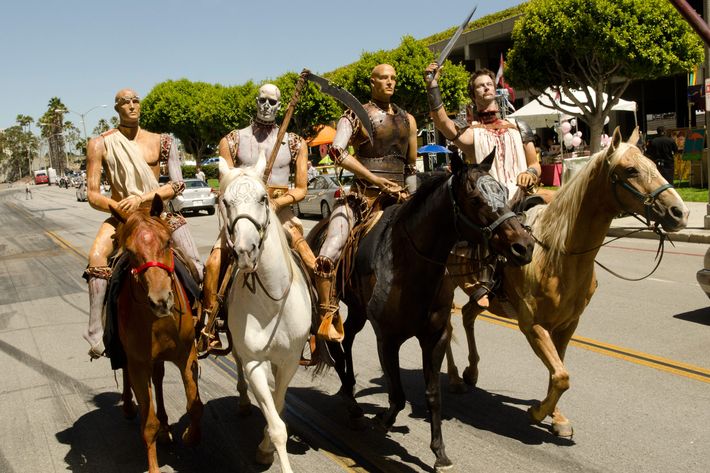
Four Horsemen of the Apocalypse (Season Six, Episode Three)
The sixth season of Dexter, featuring a serial killer inspired by the Book of Revelation, presented some of Meltzer’s greatest challenges. Chief among them: the Four Horsemen of the Apocalypse, an elaborate assemblage of severed body parts and mannequin limbs which then had to be mounted on live horses. “When you turn the script page and all of a sudden it says, There’s four horses riding down the street made up of mannequin parts and this one body that’s been severed, and a leg is over here, an arm is over there, and his head’s on one body — you kind of think the writers have lost their minds,” Meltzer laughs. Rather than the usual eights days of lead time, the prop and special-effects teams were granted three weeks to research and develop the Horsemen, a process he describes as “intense.” The final product was created with silicone body parts and mannequin pieces, connected by an armature and attached to saddles. But they had no idea if the bodies would hold together until they were actually galloping down the streets of Long Beach. “We didn’t have the time and money to build one as a prototype … we didn’t know how the horses would react to these things on their backs for hours,” says Meltzer. “And the movie gods were shining on us: The horses didn’t get spooked at all, and the bodies made it through the day. There were some issues: We were holding a couple of the limbs in place with some baling wire, because they did start to fall apart a bit after five, six times running down the street. But as we say, we got the shot.”
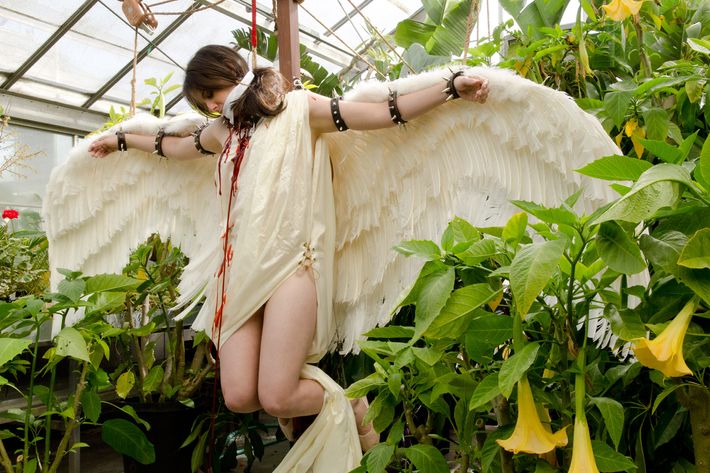
The Angel of Death (Season Six, Episode Five)
Another elaborate Doomsday tableau, the “Angel of Death” involved a woman rigged up to an elaborate killing machine in a greenhouse. When the police tripped a wire, a spiked collar stabbed the victim in the throat, raised her arms to look like wings, then unleashed a “plague of locusts” onto the police investigators. “Obviously, you’ve got to think about it in terms of production. Do you really want an entire crew in a greenhouse with locusts? So all the locusts were digital,” says Meltzer. “We’d talked about getting a dozen locusts so that we could have something that was a real element. But the CGI work these days is so good; it’s not what it was when I was doing, you know, Quincy.” The effects department handled the murder itself, which utilized a genuine mechanical contraption. “She actually was on a custom-made teeter-totter, and when we tripped the wire, she rose up, and her hands went up, and there was a blood squib on her that fired, and the blood flowed.”
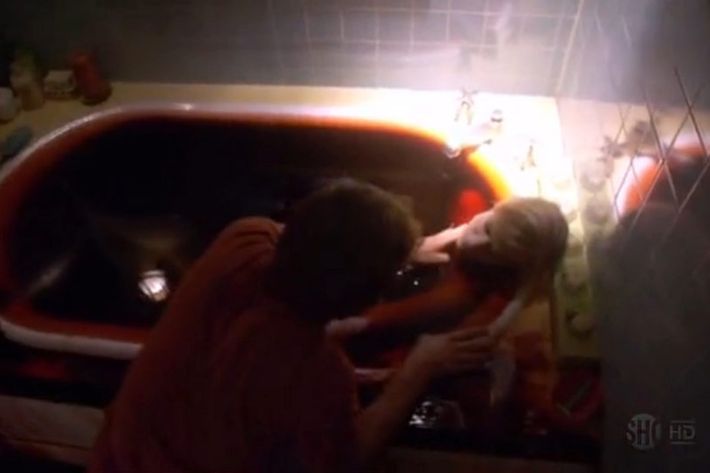
Rita’s Death (Season Four, Episode Twelve)
The shocking death of Dexter’s wife, Rita (Julie Benz), in the season-four finale was kept heavily under wraps by Dexter’s writers and producers, who tacked a fake ending on to the script. But because the Trinity Killer bled Rita to death in her bathtub, a skeleton crew was necessary to rig up the gory scene. “It was a bathtub on a soundstage, so there was no real plumbing. So we had to plumb it so we could get the blood in and then get the blood out,” says Meltzer. “It ended up being the last scene that we shot, so that we could get as many extra people out of there as possible. And it was just a surreal moment. We all knew when we were shooting this and looking at Julie in the bathtub, and the little boy on the floor, what it was gonna be for the audience when they saw it.” Though he doesn’t reveal exactly what’s going to happen in the season-seven finale, Meltzer hints that it will be a similar gut-punch to the audience. “I just got the season finale [script] yesterday, so I know now how we end season seven, and it’s phenomenal,” he gushes. “It is, without question, the best season of Dexter we’ve ever produced.”
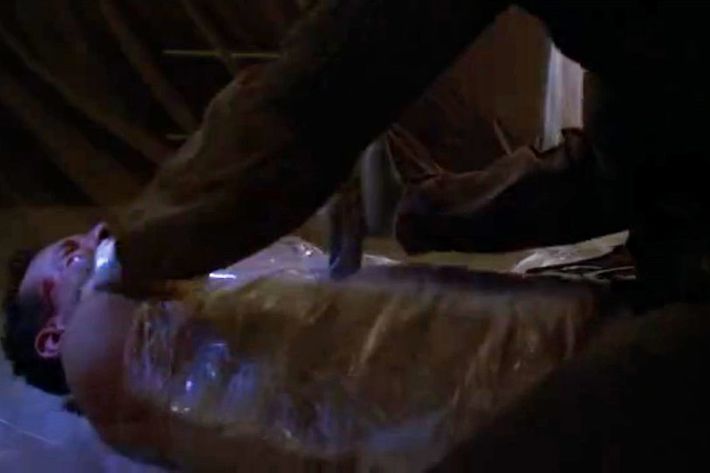
Bimini Boat Stabbing (Season Three, Episode Five)
When Dexter found out that he was going to be a father in season three, he decided to savor one last kill before retiring his “dark passenger” forever. He tracked his chosen victim, a wife-murderer named Ethan Turner, to the island of Bimini, where he stabbed him in the heart. But unlike previous kill scenes, which cut away during the moment of impact, this one showed Dexter plunging his entire knife into the body. “The director came to me and said, ‘I want you to create a retractable knife that is fully retractable,’” Meltzer told us. A fully retractable knife is a near impossibility in propdom; as a knife blade is longer than its handle, it physically can’t vanish all the way. Instead, Meltzer built three knives so the scene could be stitched together in editing: There was a real one for Dexter’s “kill kit”; a rubber one for him to swing down on his victim; and then, for the moment when the blade plunges, a retractable version where the handle was much bigger and the blade much shorter. “The only time we ever see that knife is when it’s in Dexter’s hand and it’s flying through frame for a few seconds, just as he’s plunging the knife into the actor’s chest. So it becomes a magic trick.” Obviously, Turner wasn’t Dexter’s final kill, and the three-in-one knife has gotten plenty of mileage in subsequent murder scenes.
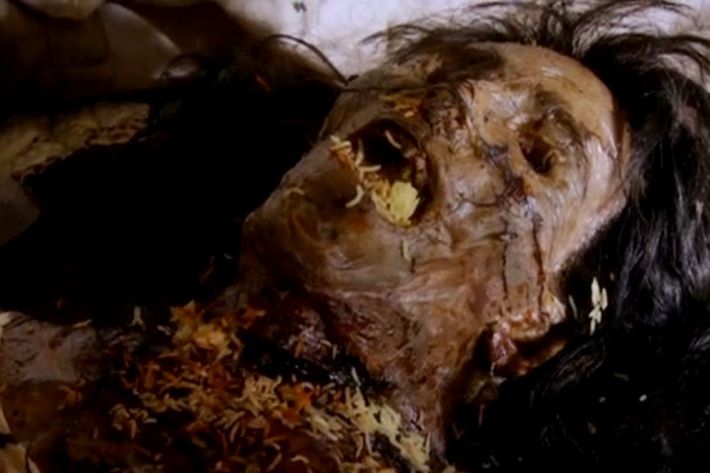
The Decomposing Couple (Season Five, Episode Five)
In season five, while Dexter was helping to avenge Lumen (Julia Stiles) against her rapists, Miami Metro was tracking a pair of immigrant murderers who were leaving Santa Muerte ritual objects at their crime scenes. Halfway through the season, Deb stumbled upon the gruesomely decomposed bodies of the killers’ first two victims, crawling with flies and maggots. When he first picked up the script, Meltzer was thrilled. “Anytime a prop master can pick up a phone and call an animal trainer and say, ‘I need 20,000 maggots’ — that’s a good day.” But he was soon to learn a hard lesson: “Twenty thousand maggots don’t go as far as you’d think they do.” To heighten the visual effect, Meltzer put a layer of brown rice underneath the live maggots, making it appear as though there were twice as many. He also brought in 5,000 horse flies to buzz around the synthetic corpses. And of course, per the dictates of the Humane Society, a licensed insect trainer supervised the entire scene.

The Trinity Killer Photographs (Season Four)
One of the prop master’s unique tasks on Dexter is handling crime-scene photography. Every murder photo that’s pinned to a bulletin board, pops up on a computer screen, or is clipped into a file was staged and photographed by Meltzer. For season four’s “Trinity Killer” arc, Meltzer had to create photo documentation of Trinity’s three types of kills: women who were stabbed in the bathtub, women who were forced to jump from great heights, and men who were beaten to death. Re-creating Trinity’s bloody history was a full day’s work for Meltzer, a team of ten makeup artists and hair stylists, and several dozen extras. “I put together a cart with all kinds of different blood mixtures and cleanup materials, and we would walk around from one bathroom on the studio lot to another bathroom on the studio lot and get all the bathroom killings,” he recalls. “And then I would find corners of buildings and outside corners of soundstages, and we’d plop a body on the ground and I’d put some blood on the wall, and that’s how we created all the jumpers. I believe there was a total of 39 killings that we staged; they all are on the Sunset Gower Studio lot, and there was a twelve-hour day of killing people and taking pictures of them.”
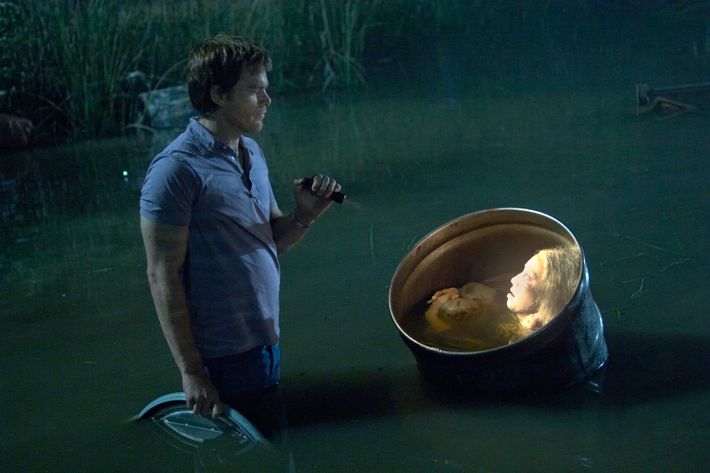
The Barrel Girls Case (Season Five)
Another gruesome photo shoot took place in season five, when Meltzer had to document the “Barrel Girls” murder case (which is exactly what it sounds like). The bodies in the live-action shots were made of silicone, but to create realistic crime-scene photos, Meltzer somehow needed to get real women into the barrels. “We started thinking, well, Why don’t we find a contortionist?” he says. “So we had auditions for women who were contortionists. Then we started thinking about trying to make oversize barrels; maybe it’s not a real barrel, but it’ll be forced perspective, and the audience won’t know that it’s two or three inches bigger, but that makes a big difference for trying to shove a body into it.” On the day of the photo shoot, Meltzer filled the custom-made barrel with warm water and glycerine (“to give more of a sickness to the water”), then let the contortionists go to work. “I got on the ladder, and we put the girls in the barrels, and I shot pictures of one after another for two hours, and then we had all the crime-scene pictures.”
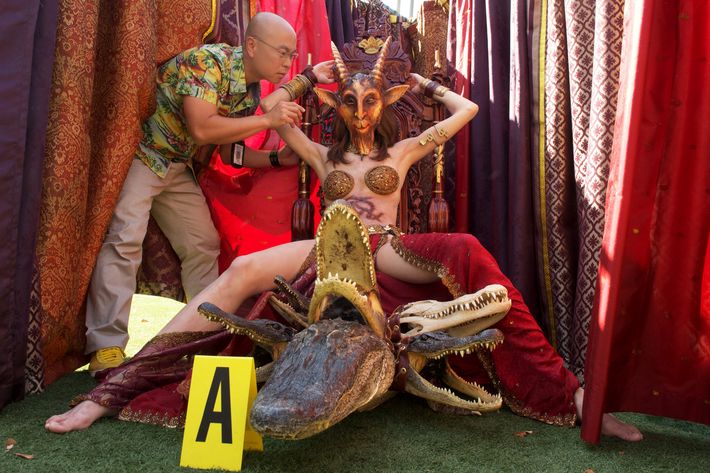
The Whore of Babylon (Season Six, Episode Eight)
“There’s a local taxidermist who works with the film industry out here, and he creates all kinds of amazing things,” says Meltzer. “I just went to him and I said, ‘So, here’s one for your files: I need to create a seven-headed alligator.’” The alligator was to become part of the “Whore of Babylon” tableau, in service of the Doomsday Killer’s Biblical agenda. (In the Book of Revelation, the Whore of Babylon appears on the back of a seven-headed beast.) “So we went through his hides, and we found the largest alligator skin that he had, and he taxidermied that, and then we just went through his stock of gator heads, and he put together this seven-headed alligator that was just simply amazing.” Because the victim in that tableau was a school teacher, the scene was shot at an elementary school. “Thankfully, school was not in session, but me walking down the street with this seven-headed alligator under my arm did turn a few heads.”

Bonus for Aspiring Prop Masters: Dexter’s Proprietary Blood Recipe
“The industry standard is that all liquid blood is a syrup base; what kind of syrup you use is where you get into your secret formulas,” Meltzer reveals. “So I have a special syrup I use for my base, and then I add food coloring. Then I add a couple drops of Dawn dish soap, because it helps with the cleanup. And then if I’m doing it outside, I add a couple drops of peppermint oil, because bees hate peppermint, so you won’t have any bee problems.” Recently, the Dexter prop department has adopted an ingenious time-saving measure: portable silicone “pools of blood,” which can be laid down underneath a victim. Meltzer augments them with reusable blood drops, which can be peeled off and stuck to a surface like Colorforms. “The cleanup is much easier; you don’t have an actor laying in a pool of syrup for hours and then dripping it all over every time we change the camera angle.”

